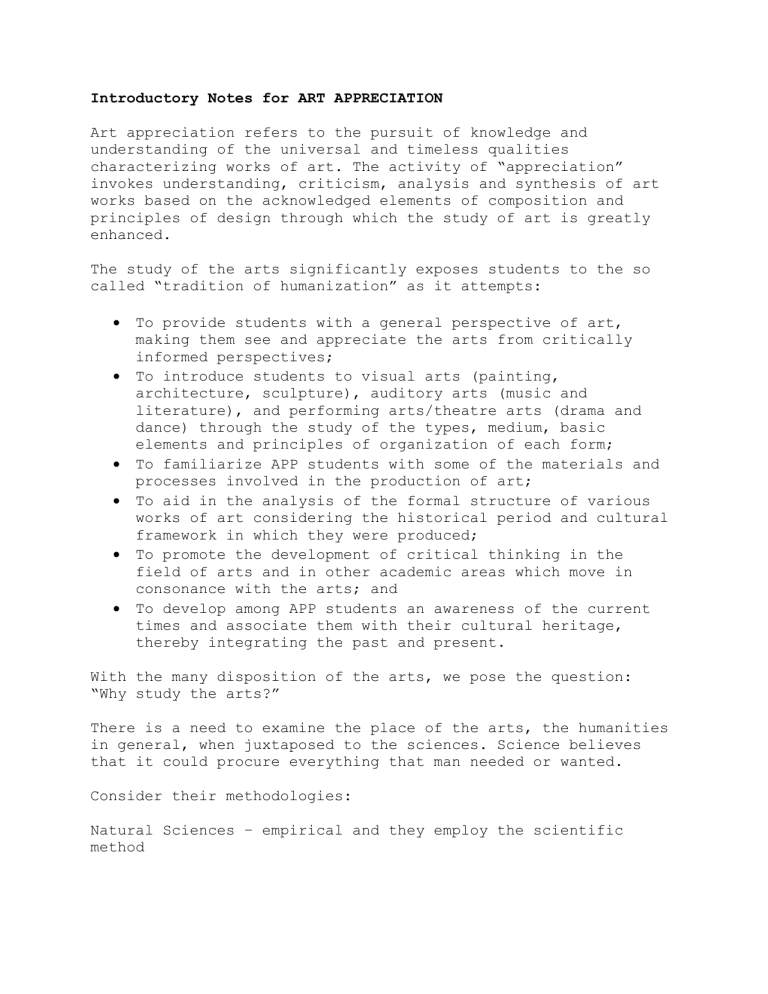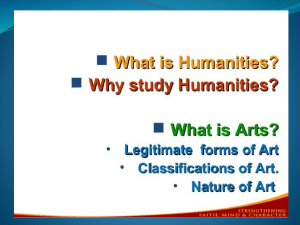
Introductory Notes for ART APPRECIATION Art appreciation refers to the pursuit of knowledge and understanding of the universal and timeless qualities characterizing works of art. The activity of “appreciation” invokes understanding, criticism, analysis and synthesis of art works based on the acknowledged elements of composition and principles of design through which the study of art is greatly enhanced. The study of the arts significantly exposes students to the so called “tradition of humanization” as it attempts: • • • • • • To provide students with a general perspective of art, making them see and appreciate the arts from critically informed perspectives; To introduce students to visual arts (painting, architecture, sculpture), auditory arts (music and literature), and performing arts/theatre arts (drama and dance) through the study of the types, medium, basic elements and principles of organization of each form; To familiarize APP students with some of the materials and processes involved in the production of art; To aid in the analysis of the formal structure of various works of art considering the historical period and cultural framework in which they were produced; To promote the development of critical thinking in the field of arts and in other academic areas which move in consonance with the arts; and To develop among APP students an awareness of the current times and associate them with their cultural heritage, thereby integrating the past and present. With the many disposition of the arts, we pose the question: “Why study the arts?” There is a need to examine the place of the arts, the humanities in general, when juxtaposed to the sciences. Science believes that it could procure everything that man needed or wanted. Consider their methodologies: Natural Sciences – empirical and they employ the scientific method Social Sciences / Commercial Sciences / Technical Sciences – statistical and they employ surveys of large populations as well as empirical evidence Humanities (the study of the arts) – neither empirical nor statistical. The only methods we enjoy in art appreciation are intuition, feeling, opinion, judgment, debate and criticism Generalization: The sciences capitalize on methods that are objective and fixed. The humanities draw its strength from subjectivity, which is should not be seen as a weakness for the field, but rather a ground to be further exposed to the so called “tradition of humanization” – a avenue for diversity, plurality, peculiarity and individualism – the individual / human person becomes the champion. The Artist and His Work / Art as a Silent Historian and Witness and a Humanizing Agent • • The arts can tell us about how men thought and felt in the historical period which produced them The arts have seen the changing image of man as he journeys across time, searches for the reality, and strives to achieve the ideals that create life Question: Why is art said to be the representation of the individual genius of its creator? One of the prominent definitions of art is that it is a record of the particular vision of an artist. The artist has selected something he has seen, felt, experience, and thought and has recorded it in an arrangement of design, color, line, mass, tones or words leading to the satisfaction of his aesthetic purpose. But the artist has also been influenced, consciously or unconsciously, by other determining factor such as the environment, traditions, national traits, religious beliefs, economic condition, geography and climate.

